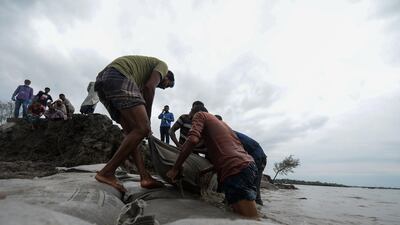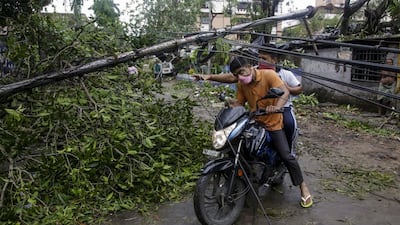Coronavirus-hit Mumbai appeared to escape the worst of Cyclone Nisarga on Wednesday as the first severe storm to threaten India's financial capital in more than 70 years left it largely unscathed after ripping roofs off buildings in nearby coastal towns.
Mumbai and its surrounds are usually sheltered from cyclones - the last deadly storm to hit the city was in 1948 - but authorities evacuated at least 100,000 people, including coronavirus patients, from flood-prone areas in the states of Maharashtra and Gujarat.
The storm made landfall near the coastal town of Alibag, around 100 kilometres (60 miles) south of Mumbai, on Wednesday afternoon, meteorologists said.
It then crossed Maharashtra's coast, with its path veering to the east of Mumbai and gradually weakened by Wednesday evening, they added.
The cyclone brought heavy rainfall - with winds of 100-110 kilometres per hour (60-70 miles per hour) and gusts of up to 120 kph.
In Mumbai – home to Bollywood, India's largest stock exchange and more than 18 million residents – high winds whipped skyscrapers and ripped apart shanty houses near the beach.
"The intensity is very strong and nothing like weather events we've seen before," said Milind Dhodre, who lives in Alibag with his wife and son. The 45-year-old professor was rescued from his house near the sea.
The cyclone brought heavy rainfall - with winds of 100-110 kilometres per hour and gusts of up to 120kph.
Earlier, authorities were working around the clock to move thousands of people away from the coast, amid fears that a city ravaged by coronavirus infections could overwhelm its healthcare system further.
Homes in a nearby slum had been locked up, and municipal officials patrolled the streets, using megaphones to order people to stay inside.
"We have seen rains, but we have never seen a cyclone in the city. We don't know what damage it will do," said Shantaram Terekar, who lives in a one-room hutment in the city.
Mr Terekar said he had switched off electricity and used tarpaulin to secure his thin metal roof.
India's largest container port, Jawaharlal Nehru Port Trust, on the outskirts of Mumbai, said it had shut for 24 hours. Flights scheduled to operate from Mumbai's airport were cancelled.
Early on Wednesday, the state of Goa, south of Maharashtra, received 127 millimetres of torrential rain – about a week's average – as the cyclone moved along the coast, the meteorological agency said.
More than 100,000 people had been moved to safety along the coasts of Maharashtra and Gujarat states.
Cyclones often skirt Mumbai during the June-September monsoon season and torrential rains flood roads, and bring a halt to a suburban railway service that serves millions of people.
Mumbai emergency services are already struggling with the nation's largest outbreak of the coronavirus. The city and its surrounding areas have so far reported about 55,000 Covid-19 cases and more than 1,700 deaths from the disease.
“If hospitals and clinics are damaged by the cyclone, the city won’t be able to cope with the large number of Covid-19 cases, and social-distancing measures will become virtually impossible to follow,” Bidisha Pillai, chief executive of Save the Children in India, said.
“Let us fight this danger like we are standing up to the corona pandemic and are on our way to defeat it. Likewise, we will prevail over this situation too!” Maharashtra's Chief Minister Uddhav Thackeray tweeted.
In Mumbai, authorities shifted 150 Covid-19 patients out of a makeshift hospital as it was in a low-lying area.
Nisarga comes two weeks after Cyclone Amphan struck the Bay of Bengal on India’s east coast and battered West Bengal state, killing more than 100 people in India and neighbouring Bangladesh.





























